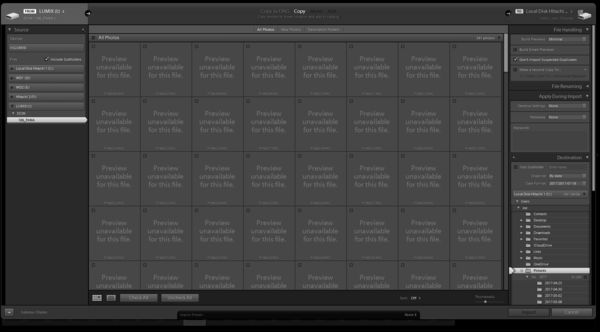Posts for: joegim
Aug 7, 2017 01:37:35 #
Aug 6, 2017 13:27:34 #
leftj wrote:
It couldn't. He's got it reversed.
A 60mm lens on a APS-C body gives the same coverage as a 90mm lens on a full frame body. My Micro 4/3 25mm lens gives the same coverage as a 50mm lens on a full frame body.
Jul 28, 2017 00:52:23 #
Jul 28, 2017 00:52:22 #
Thanks burkphoto for the info. B&H was wrong. My Lumix 45-200 OIS xoom will definitely not do dual IS with my Olympus OM-D E-M5. Olympus has only 2 lenses so far with OIS. Only about a dozen Lumix OIS lenses have dual IS capability. And of course dual IS functionality will not work between a Lumix lens and an Olympus body & vice versa. About Olympus IBIS being that good, I tried it out today. An Oly OMD E5 with IBIS did a better job than my Lumix G7 using OIS with the same Lumix 14-42 OIS zoom. And yes I sometimes use a vintage Nikkor 55mm f3.5 Micro lens on the Oly body and it works.
Jul 24, 2017 23:22:19 #
David in Dallas wrote:
I would agree that anamorphic distortion is specif... (show quote)
Interestingly one way to minimize distortion is to have a cylindrical film "plane". A rotating drum with a vertical slit the progressively exposes the film. See this:
https://www.youtube.com/watch?v=6Ntd868kuTE
Jul 24, 2017 11:59:27 #
Gragonophile - to add what Peterff has said, the "distortion" that's mostly associated with wide angle lenses is not a lens flaw but that it's just how optics works. If you were to take a photo of the whole ship with the lens set at 24mm you would definitely notice the telltale "fisheye" effect where it looks that a print had been pasted to a sphere giving that effect where lines are not straight but curved. Now if you were to take same photo with the lens set to say 85mm at the same distance you would have to take probably 4 or 5 images and then stitch them together to get a photo of the whole ship. After you stitch the photos, guess what? You will still get the same "fisheye" effect and the two photos look the same. So the lens focal length has nothing to do with the fisheye distortion.
Remember perspective is dependent only on subject to camera distance, regardless of lens. If wide angle lenses, say a 35 mm FF had inherent distortions, then all photos taken by this lens would be distorted. But the distortion only appears only at close distances. Move away from the subject and the distortion is minimized or eliminated. Conversely move away from the ship far enough so you could take a photo of the whole ship with the lens set at say 105mm. Then at the same distance take another shot with the lens set at 24 mm. Enlarge the 24mm shot and compare it with the 105mm shot - they will look the same! Another test - take a picture of the Grand Canyon & a big mountain range a mile away with the lens set at 24mm and you'll hardly notice any distortion because of the great subject to camera distance.
That is why portrait photographers like to use the "portrait" lenses - 85 or 105 mm FF because they have a very pleasing perspective especially on head shots. This not because they inherently have less distortion than the "normal" 50mm lens but because it forces the photographer to increase his subject to camera distance giving a more pleasing perspective - the nose is less prominent compared to the 50 mm shot. Shoot with a 24 mm at a closer distance and the you'll a cartoonish perspective with a very prominent nose.
Remember perspective is dependent only on subject to camera distance, regardless of lens. If wide angle lenses, say a 35 mm FF had inherent distortions, then all photos taken by this lens would be distorted. But the distortion only appears only at close distances. Move away from the subject and the distortion is minimized or eliminated. Conversely move away from the ship far enough so you could take a photo of the whole ship with the lens set at say 105mm. Then at the same distance take another shot with the lens set at 24 mm. Enlarge the 24mm shot and compare it with the 105mm shot - they will look the same! Another test - take a picture of the Grand Canyon & a big mountain range a mile away with the lens set at 24mm and you'll hardly notice any distortion because of the great subject to camera distance.
That is why portrait photographers like to use the "portrait" lenses - 85 or 105 mm FF because they have a very pleasing perspective especially on head shots. This not because they inherently have less distortion than the "normal" 50mm lens but because it forces the photographer to increase his subject to camera distance giving a more pleasing perspective - the nose is less prominent compared to the 50 mm shot. Shoot with a 24 mm at a closer distance and the you'll a cartoonish perspective with a very prominent nose.
Jul 21, 2017 20:16:56 #
https://www.facebook.com/NYPost/videos/10158416827485206/
Bumped into this guy last Wednesday at Midtown Manhattan just as I was going into B&H Photo to get an Olympus E-M5. I was surprised to see this well dressed gentleman holding a Speed Graphic camera. And he told me he takes Polaroid photos with this camera.
Bumped into this guy last Wednesday at Midtown Manhattan just as I was going into B&H Photo to get an Olympus E-M5. I was surprised to see this well dressed gentleman holding a Speed Graphic camera. And he told me he takes Polaroid photos with this camera.

Jul 20, 2017 22:37:09 #
Jul 20, 2017 22:36:28 #
I liked that 4th image. I have a similar image of that same flower but with a bee on it taken at the Queens Botanical Garden in NYC. Nice photos.
Jul 20, 2017 20:15:29 #
dmsM43 My Lumix 14-42 does not have a OIS switch but the 45-200 does. When I turn on the OIS switch of the 45-200 there seems to be no difference in the IS performance. And it definitely DOES NOT degrade the IS performance. I called Olympus support regarding this and the lady was evasive about this issue saying they have no info regarding other manufacturer's lenses mounted on the E-M5. I find that a little strange because if there was in fact a degradation in the IS performance that rep would have definitely mentioned that. Maybe they don't want people to know that they can have dual IS on a E-M5 if they mount a Lumix lens with OIS?? I then called B&H tech support and the person said that the Lumix lens mounted on the E-M5 will have dual IS! Anybody has further info regarding this because I also heard on a You Tube video that such a setup will have dual IS.
You mentioned that the latest Olympus cameras have dual IS. Does it mean that Olympus now makes lenses with OIS?
You mentioned that the latest Olympus cameras have dual IS. Does it mean that Olympus now makes lenses with OIS?
Jul 20, 2017 13:37:31 #
Just got a refurbished Olympus OMD E-M5 body from B&H yesterday. I have Lumix 14-42 & 45-200 zooms which have Optical Image Stabilization built into the lens. The Olympus has it's own 5 axis In Body Image Stabilization. Does the lens OIS still function when mounted on the Olympus? Do I now have a dual stabilized system or will the camera override the lens OIS? The good thing with the Olympus is that I can now use my Nikkor 55mm Micro lens with Image Stabilization.
Jul 19, 2017 21:26:49 #
jerryc41 - did as the link you pointed out suggested & LR now shows both the RW2 & JPEG files. My fault - I forgot to mention earlier that I had the camera set to RAW + JPEG and it was creating two images, one RW2 & JPEG with the same file number. Thank you very much.
Thanks to all others who gave suggestions too. I do not have a problem with LR processing the RW2 files because I have already downloaded the Adobe DNG converter so I'm able to convert my RW2 files to Adobe DNG files which my LR can process. My version of LR does not have support for Lumix RW2 files. Also I'll make it a habit of copying the files to my HD before importing them into LR so I'm not working on the original image.
Thank you all.
Thanks to all others who gave suggestions too. I do not have a problem with LR processing the RW2 files because I have already downloaded the Adobe DNG converter so I'm able to convert my RW2 files to Adobe DNG files which my LR can process. My version of LR does not have support for Lumix RW2 files. Also I'll make it a habit of copying the files to my HD before importing them into LR so I'm not working on the original image.
Thank you all.

Jul 19, 2017 02:17:46 #
BTW when I import images to LR from my hard drives all the images, RAW & JPEG are recognized. It's only when I'm importing from the card reader that LR does not see the JPEG images.
Jul 18, 2017 23:49:03 #
I'm new to Lightroom and this thing is bugging me. When I try to import my images from the card reader LR only shows the RW2 files (a Panasonic Lumix RAW format) and does not display the JPEG images. When I view the same folder in Windows 10 Explorer the RW2 file(shown only as an icon) as well as the JPEG file (shown as an image) images are displayed. And since LR 5.7.1 does not have native RAW support the RAW images are not even displayed, instead a message says " Preview unavailable for this file". I understand about the RAW images not being displayed but why does LR not even see the JPEG images?


Jul 18, 2017 14:08:49 #
To eliminate or minimize the convergence of vertical lines, shoot at the practically furthest distance from the subject. The closer you are at an object the more prone you are to distortions regardless of lens. Shots of a building say 50 ft. away with a 28 mm & a 85mm FF lenses will produce the same perspective & distortions. A shot of that building with the 28 mm lens that fills the frame will have more distortions than the one shot with the 85 mm that fills the frame.
